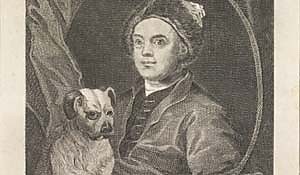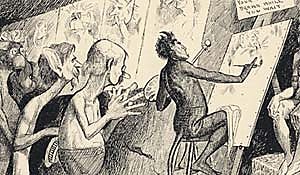|
Introduction
by Kent C. Boese
The
Smithsonian Institution Libraries has a substantial collection of
cartoon and caricature books. While these materials can be found
in several branch libraries - such as the Cooper-Hewitt, National
Design Museum Library or the National Museum of American History
Library - the largest concentration is at the Smithsonian American
Art Museum/National Portrait Gallery Library (AA/PG). The collection
at AA/PG includes general collections, rare, and special collections
titles which date from 1800. Currently numbering over 600 volumes,
this growing collection has a strong focus on the works by American
artists - the oldest dating to the Civil War period.
 The
significance and importance of cartoons and caricatures are often
overlooked in preference to their humorous aspects, yet their power
and pervasiveness cannot be ignored. The English cartoonist, William
Hogarth (1697-1764), especially with his print series', shed light
on the seedier and immoral face of London as a commentary on societal
ills. The widespread popularity and distribution of Hogarth's work
encouraged English lawmakers to act and address the social problems
of their age. The
significance and importance of cartoons and caricatures are often
overlooked in preference to their humorous aspects, yet their power
and pervasiveness cannot be ignored. The English cartoonist, William
Hogarth (1697-1764), especially with his print series', shed light
on the seedier and immoral face of London as a commentary on societal
ills. The widespread popularity and distribution of Hogarth's work
encouraged English lawmakers to act and address the social problems
of their age.
From
Hogarth's time, the power of cartoons has increasingly been used
to full advantage. Artists have used them to help topple governments,
imprison corrupt politicians, win elections, address societal ills,
win support for wars, and to just help readers laugh at themselves.
Abraham Lincoln (1809-1865) recognized this power when he referred
to the drawings of Thomas Nast (1840-1902), and commented that Nast
was one of the best recruiting sergeants the Union Army had. Nast's
drawings in Harper's Weekly also assisted in Lincoln's re-election.
Not surprisingly, cartoons have accompanied, chronicled, and commented
on every war and election in American history.
The
power and popularity of cartoons derives from a couple of elements.
First, they are largely or entirely graphic. This was especially
important before universal literacy and made them accessible to
all who saw them, regardless of social class, race, or national
origin - and this is still important today. Second, cartoons are
widely distributed and easily accessible to all. The popularity
they enjoy in magazines and newspapers are just as visible today
as they were in the nineteenth century. Nineteenth century newspapers,
in fact, recognized the popularity of cartoons and often sought
to outdo each other to increase circulation. While this competition
began with merely trying to publish the best cartoonists' work,
it eventually led to the creation of the daily comics, the comic
strip, and the use of color on Sunday.
 Fortunately,
cartoonists and publishers have been acutely aware of the cartoon's
importance, and re-published many of the better examples of this
art in book form. Were it not for their foresight, much of what
we currently have would either have been lost due to the ephemeral
quality of newsprint, or be known only through reproductions in
microfilm. Instead, we have a rich image legacy providing modern
viewers a glimpse of the important issues of the past. Fortunately,
cartoonists and publishers have been acutely aware of the cartoon's
importance, and re-published many of the better examples of this
art in book form. Were it not for their foresight, much of what
we currently have would either have been lost due to the ephemeral
quality of newsprint, or be known only through reproductions in
microfilm. Instead, we have a rich image legacy providing modern
viewers a glimpse of the important issues of the past.
|


